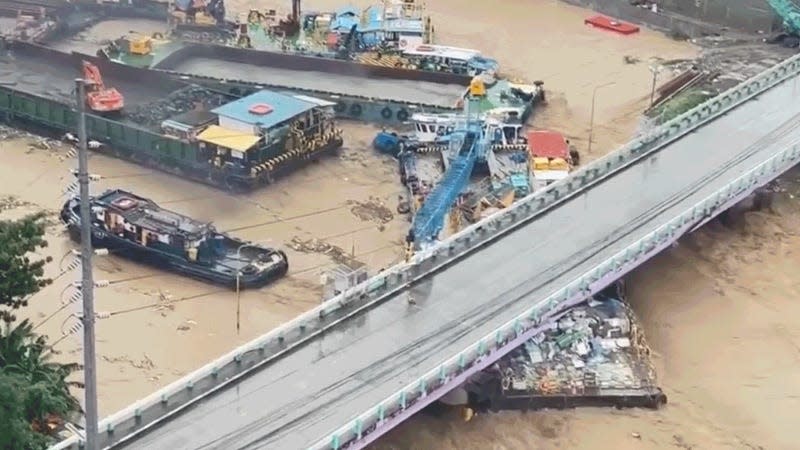Watch Typhoon Storm Surge Slam Barges Into Bridge In The Philippines
A recent natural disaster revealed both the power of nature and the resilience of man-made structures. As Typhoon Gaemi, a formidable Category 4 storm, swept across East Asia, it unleashed a catastrophic surge that thrust multiple barges against the F. Manalo Bridge in Pasig City, Philippines. The incident serves as a stark reminder of the unpredictable forces of nature and their potential to disrupt everyday life.
The Collision: A Harrowing Scene
The dramatic viral footage captured by Alex Rellosa from her apartment balcony illustrates the sheer force of the storm. In the video, rushing muddy waters, intensified by torrential rains, violently collide with three barges, causing them to slam into the low bridge's road deck. The tension-filled atmosphere is palpable as Rellosa recounts, “I already heard screaming, that’s why I went out to the balcony. I saw there were people stranded on the barges.” Her firsthand observation echoes the chaos that unfolded on that fateful day.
The typhoon wreaked havoc across its path, leaving behind a wake of destruction. In total, at least 21 lives were lost, and over half a million residents were displaced as storm surges and gale-force winds wreaked havoc on infrastructure. With maximum wind speeds of up to 145 miles per hour and rain accumulation reaching a staggering foot in Manila, it was a calamity that the region had not anticipated.
A Bridge That Withstood the Storm
While the barges were unable to navigate the storm's fury and ended up crashing into the bridge, it is noteworthy that the F. Manalo Bridge held its ground against the impact. In contemporary times, where engineering marvels often face scrutiny regarding their durability against natural disasters, this incident provides a glimmer of positivity amidst the turmoil.
However, while this bridge survived, the Philippines faced significant maritime disaster elsewhere. The typhoon's violent swells contributed to the tragic capsizing of the oil tanker MT Terra Nova in Manila Bay, which was carrying nearly 400,000 gallons of industrial oil. As the vessel sank, it began leaking oil, threatening the pristine waters and ecosystems of Manila Bay. Reports indicate that this catastrophe could result in one of the largest oil spills in the country’s history, with undetermined implications for marine life and coastal communities.
The Broader Impact of Typhoon Gaemi
Typhoon Gaemi has left an indelible mark on the Philippines, showcasing the vulnerability of both people and infrastructure in the face of catastrophic weather events. The storm's aftermath is filled with tales of loss and survival, as communities come together to recover. Efforts are now underway to assist those displaced by the storm, with local and international organizations mobilizing resources to provide shelter, food, and medical care.
The environmental consequences from the capsizing of MT Terra Nova will demand immediate and sustained response efforts. Cleaning up the spill and mitigating its effects on marine life will be an arduous process, yet one that is essential for the restoration of affected environments and communities.
Conclusion
In the wake of Typhoon Gaemi, the Philippines stands resilient, confronting challenges presented by both nature and human-made disasters. While the F. Manalo Bridge managed to withstand the impact of the barges during the storm, the catastrophic oil spill necessitates an urgent and robust response. This latest disaster is a sobering reminder of the forces that shape our world and the importance of preparedness in the face of uncertainty. The resilience of the Filipino people, their unyielding spirit, and community solidarity will undoubtedly play a crucial role in the recovery and rebuilding process ahead.
For the latest updates on the disaster recovery efforts and ongoing news coverage, you can follow us on Facebook, Twitter, and Instagram.
